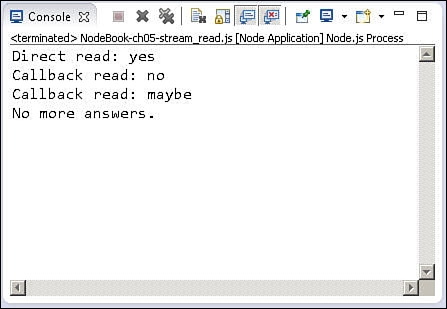Readable Streams
Readable streams are designed to provide a mechanism to easily read data coming into an application from another source. Some common examples of readable streams are:
![]() HTTP responses on the client
HTTP responses on the client
![]() HTTP requests on the server
HTTP requests on the server
![]()
fs read streams
![]()
zlib streams
![]()
crypto streams
![]() Child processes
Child processes stdout and stderr
![]()
process.stdin
Readable streams provide the read([size]) method to read data, where size specifies the number of bytes to read from the stream. read() can return a String object, Buffer object or null. Readable streams also expose the following events:
![]() readable: Emitted when a chunk of data can be read from the stream.
readable: Emitted when a chunk of data can be read from the stream.
![]() data: Similar to
data: Similar to readable, except that when data event handlers are attached, the stream is turned into flowing mode, and the data handler is called continuously until all data has been drained.
![]() end: Emitted by the stream when data will no longer be provided.
end: Emitted by the stream when data will no longer be provided.
![]() close: Emitted when the underlying resource, such as a file, has been closed.
close: Emitted when the underlying resource, such as a file, has been closed.
![]() error: Emitted when an error occurs in receiving data.
error: Emitted when an error occurs in receiving data.
Readable stream objects also provide a number of functions that allow you to read and manipulate them. Table 5.4 lists the methods available on Readable stream objects.
To implement your own custom Readable stream object, you need to first inherit the functionality for Readable streams. The simplest way to do this is to use the following code, which uses the util module’s inherits() method:
var util = require('util'),
util.inherits(MyReadableStream, stream.Readable);
Then you create an instance of the object call:
stream.Readable.call(this, opt);
You will also need to implement a _read() method that calls push() to output the data from the Readable object. The push() call should push either a String, Buffer, or null.
The code in Listing 5.6 illustrates the basics of implementing and reading from a Readable stream. Notice that the Answers() class inherits from Readable and then implements the Answers.prototye._read() function to handle pushing data out. Also notice that on line 18, a direct read() call reads the first item from the stream, and then the data event handler defined on lines 19–21 reads the rest of the items. Figure 5.6 shows the output for Listing 5.6.
Listing 5.6 stream_read.js: Implementing a Readable stream object
01 var stream = require('stream'),
02 var util = require('util'),
03 util.inherits(Answers, stream.Readable);
04 function Answers(opt) {
05 stream.Readable.call(this, opt);
06 this.quotes = ["yes", "no", "maybe"];
07 this._index = 0;
08 }
09 Answers.prototype._read = function() {
10 if (this._index > this.quotes.length){
11 this.push(null);
12 } else {
13 this.push(this.quotes[this._index]);
14 this._index += 1;
15 }
16 };
17 var r = new Answers();
18 console.log("Direct read: " + r.read().toString());
19 r.on('data', function(data){
20 console.log("Callback read: " + data.toString());
21 });
22 r.on('end', function(data){
23 console.log("No more answers.");
24 });


